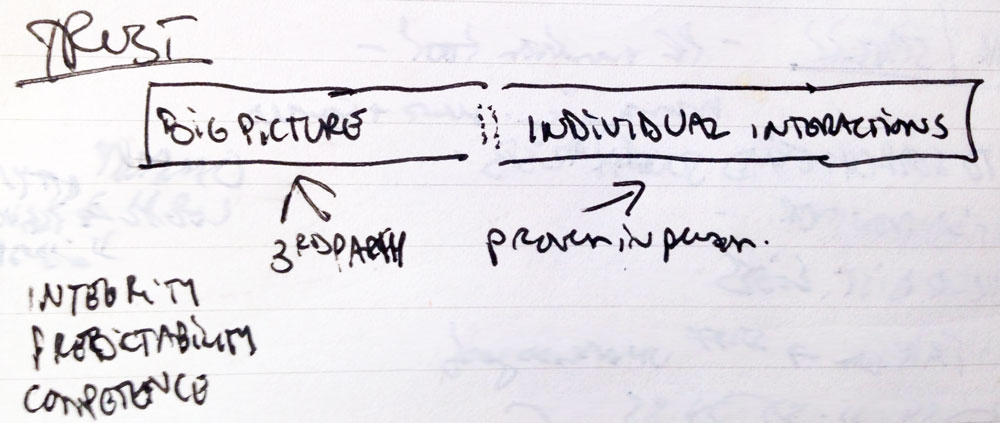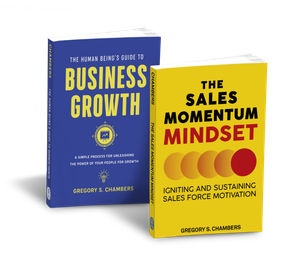Earning Trust and New Business
[av_textblock textblock_styling_align='' textblock_styling='' textblock_styling_gap='' textblock_styling_mobile='' size='' av-desktop-font-size='' av-medium-font-size='' av-small-font-size='' av-mini-font-size='' font_color='' color='' id='' custom_class='' template_class='' av_uid='av-lfwktxko' sc_version='1.0' admin_preview_bg='']
Earning Trust and New Business

"I don't think they believed me," he said while we wait for the elevator to arrive. "What do you think?"
"I agree," I said.
"Well, what would you do differently?"
The elevator arrives, we walked in, and punch "G," triggering the doors to close.
"I wouldn't do anything different. You did well."
"But I didn't get anything." He blew air from his nose. "It's just like always. I get an appointment, we have a nice conversation and nothing happens. You're supposed to help, aren't you? You're the guru." He lets that hang while the doors open to the garage. "What am I doing wrong?"
It's a great question. Boiling over with hundreds of assumptions and thousands of days of life experiences from a man who, from the outside, has everything going for him. Except a stable of new clients banging down the door to do business with him. His firm's essential requirement for advancement. He is stressed.
"Let's talk about this tomorrow. I have an idea that will work for you, but I don't have time to go into it right now. How about I meet you early for coffee?" It sounds like a stall, and it is. I need to meet his managing partner for drinks, but announcing this might send him into a barricade at ninety miles and hour with no skid marks.
"Fine. I'll meet you in the lobby at 6:30."
Man, these guys get up early, I think.
The next day
He has coffee waiting for me at a window table, punctual as always. A serious look on his face. Someone not used to having problems he can't solve on his own.
"What do you have for me?" Straight to the point.
I pull my notebook out and set it on the table. "First, let me ask you this. Was the woman we met yesterday, familiar with your firm?"
"Yes. Everyone knows us. That's part of the problem as I see it. . ."
I held up a finger.
"Before we talk about that, I have one more question for you. Did she know you?"
"What do you mean? Like before yesterday?"
"Exactly. Before we sat in her conference room, did she know you."
"No, we only talked on the phone. What does that have to do with anything?"
"A lot," I look him in the eye, "What's your plan for follow up?"
"I have her on the schedule to check back in two months."
"To talk about what?"
This question belches his frustration on the table, "I don't know, to check in, to give her some new information, to pitch her again," he put his arms out with his palms up, like he is waiting to receive something. "What? Are you saying I need to follow up sooner or something? I don't see how that will fix anything."
"I want to show this to you," I said, and open my notebook, made a heading called "Trust", made a horizontal bar, and divide it in two with dotted lines.

"Trust is the building block of business. Nothing good happens without it, and firms like yours depend on it. From our prospect's point of view, they need to trust you in order to consider working with you. Think of that coming in two parts. Big Picture trust and the trust that comes from Individual Interactions."
"I don't understand why you split that up.," he said as he leans in and pointed to the labels.
"When I asked if she was familiar with your firm, that's big picture trust. Seventy years in the area, trusted partner to hundreds of important businesses, community sponsors, stuff like that. Individual interactions that build trust are separate from the big picture stuff. Think of the trust that comes with knowing a person for a long time, having kids the same age, going to the same school, working for the same committees, places where she sees an individual. Think about the trust that builds that way."

"I see," he said as I label the Big Picture as 3rd party, and Individual Interactions as proven in person.
"So, what I want you to think about is what you are doing as an individual to build trust. Let's start with this question, what do others have to do with you to build trust?"
He thinks for a minute, then says, "Me?" I nod. "Honesty. I look for that. And things like follow through, you know, doing what you say you'll do. Is that what you're looking for?"
I nod my head and start writing. "Yes. Exactly. You're saying that you look for Integrity, and Predictability, and there's another one important to your prospects. Competence."

He nods along with me now and sits back in his chair, a little more relaxed.
"So, let me tell you what I heard yesterday," I said. "I heard a competent individual from a big name firm starting to establish trust. So, yesterday, in the elevator, when I said that I wouldn't change anything, I was serious. Competence is a big part of what you need to demonstrate, and you're on the right path."
He smiles at me, "But. . ."
"But. . .now you need to work on the other parts of trust. She mentioned what's happening in a few areas of her business and you gave some high level advice. Continue with that, but don't wait sixty days with more information. To build predictability, you need to be there. Consistently."
"What about integrity?" he asks, pointing at the list.
"Your profession has a lot of Big Picture trust built into it. So, as an individual, how would you demonstrate trust?"
He thinks for a few seconds, "I don't know, by respecting her privacy, following up on any requests, things like that?"
"A good start."
He contemplates.
"But what about the new business? How do I get her to start using us?" The look of concern comes back to his face.
"That, my friend, is where you need to add some language to each interaction. And we'll work on that, but I can give you one that will work for you, right now."
He takes out a pen and opens his notebook. "Hit me," he said, clicking the pen.
"Add this to your language every time you find yourself offering advice or commenting on an issue you can help them with. That's your trigger. 'Oh, I'm offering advice again.' Whent this happens, in your own words, say, 'I actually do this kind of work for clients. Would you like me to work up a few options for how we could work together?' and listen for an answer that suggests you've earned trust."
He writes this down and looks up. "That's it?"
"For you, that's it. You have a number of people you've been talking to. Getting back in front of them, listening, and recognizing when you give advice is harder than it sounds right here. Recognizing the trigger and remembering to ask this question is the first step."
He looks at me and a smile creeps into the corner of his mouth. "Walk before running, right?"
"You got it," I said. "You have to start with what you can live with and go from there.
"Good stuff."
"Yes, good stuff," he said.
[/av_textblock]





